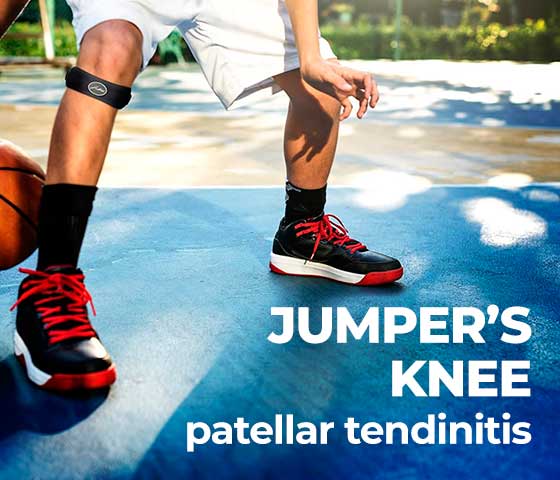“Jumper’s knee” also known as patellar tendinitis, is a common condition among athletes, particularly those involved in sports that require repetitive jumping motions, such as basketball and volleyball. It involves inflammation or injury to the patellar tendon, which connects the kneecap (patella) to the shinbone (tibia).

The repetitive stress from jumping and landing can cause tiny tears in the tendon, leading to pain, swelling, and stiffness in the front of the knee, just below the kneecap. Also, overuse, inadequate warm-up, poor biomechanics, and insufficient rest between activities are common contributing factors.
At Revolve Physiotherapy in Milton, we provide techniques to improve biomechanics, strengthening and flexibility exercises for jumper’s knee rehabilitation, aimed at reducing pain and inflammation, improving strength and flexibility, and gradually reintroducing activity.
Here’s a general outline of a rehabilitation program:
Rest and Activity Modification: Initially, it’s important to rest the affected knee to allow the tendon to heal. Avoid activities that exacerbate pain, such as jumping or squatting. Modify activities to reduce stress on the knee, such as using a knee brace or taping for suppor.
Ice: Use ice packs on the knee for 15-20 minutes several times a day to reduce pain and inflammation.
Modalities: Therapeutic modalities such as ultrasound, electrical stimulation, or laser therapy may be used to help reduce pain and promote healing.
Biomechanical Assessment and Correction: Address any biomechanical issues or movement patterns that may contribute to jumper’s knee. For example, this may involve gait analysis, footwear assessment, or orthotic prescription to improve alignment and reduce stress on the knee joint.
Gradual Return to Activity: Progressively reintroduce activities that involve jumping and landing, starting with low-impact exercises and gradually increasing intensity and volume as tolerated. Listen to your body and avoid pushing through pain.
Monitoring and Maintenance: Once symptoms improve, continue with a maintenance program of stretching, strengthening, and conditioning exercises to prevent recurrence. Pay attention to proper warm-up and cool-down techniques before and after activities.
Rehabilitation timelines can vary depending on the severity of the injury and individual factors. Above all, it’s essential to work closely with your phisiotherapist to develop a personalized rehabilitation plan tailored to your needs and goals.
Here are some exercises commonly included in a rehabilitation program for jumper’s knee rehabilitation:
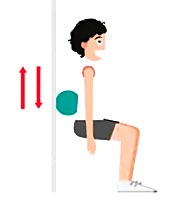
Wall Squat: Stand with your back against a wall, with a ball between you and the waal, and feet hip-width apart. Slowly slide down the wall into a partial squat position, keeping your knees aligned over your ankles and tracking in line with your toes. Hold for a few seconds, then slide back up. Repeat 10-15 times for 2-3 sets.
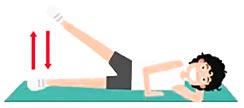
Side lying: Lie on your side with your bottom leg bent slightly for stability and your top leg extended straight. Keep your body in a straight line. Your top hand can be placed in front of you for support. Lift your top leg keeping it straight. Lift to a point where you feel a contraction in your outer thigh and hip area. Slowly lower your leg back down to the starting position. Repeat 10-15 times on each side.
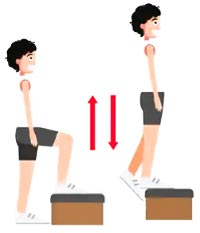
Step-Ups: Stand facing a step or sturdy platform. Step up onto the platform with one foot, keeping your knee aligned over your ankle. Straighten your hip and knee as you come up onto the step, then slowly lower back down. Perform 10-15 repetitions on each leg for 2-3 sets.
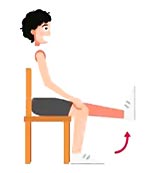
Straight leg raise: Sit on a chair with your back straight and your feet flat on the floor. Straighten one leg out in front of you, keeping your knee as straight as possible but not locked. Tighten the muscles in your thigh and slowly raise your straightened leg upward until it’s parallel to the floor. Keep your foot flexed throughout the movement. Hold for a moment, maintaining tension in your quadriceps muscle. Slowly lower leg back down. Repeat for 10-15 times on each leg.
These exercises should be performed with proper form and technique, focusing on controlled movements and avoiding any pain or discomfort. Start with low resistance and gradually increase as your strength and tolerance improve. In addition, prevention strategies include proper warm-up, using appropriate footwear, and incorporating rest periods into training schedules to allow for adequate recovery.
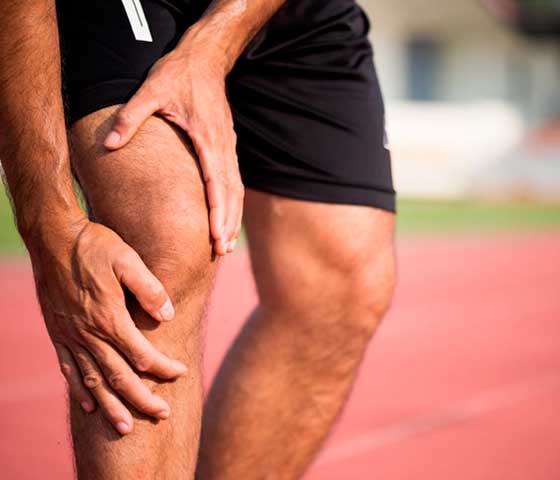
It’s essential to consult with a healthcare professional or physiotherapist before starting any exercise program, especially if you have a history of knee pain or injury. We can provide guidance on the most appropriate exercises for your specific condition and help monitor your progress.
Jumper´s Knee ( patellar tendinitis) Rehabilitation in Milton. We will provide you the best assistance to get you back in the game! Call us today at (905) 864-8181.
